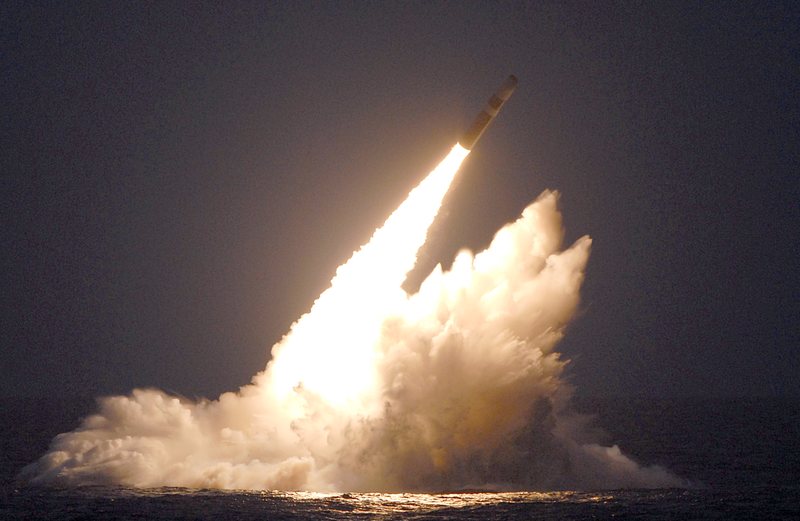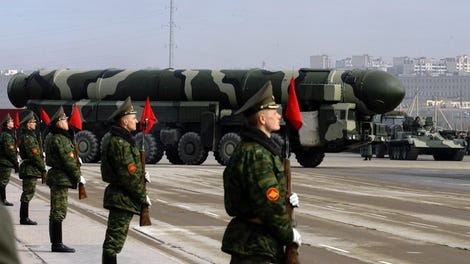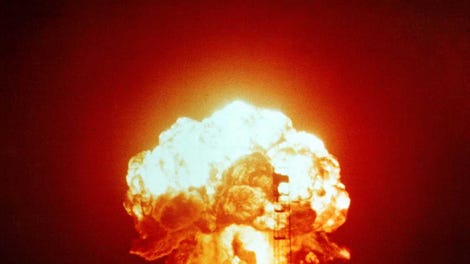
A new “super-fuze” device incorporated into submarine-launched ballistic missile warheads are so deadly and accurate that they could possibly wipe out an entire fleet of Russian intercontinental ballistic missiles (ICBMs) in their silos, creating a preemptive strike-first capability that would give Russia little time to respond. And it’s the sort of thing that’s been driving Russia nuts.
Advertisement
Since 2009, the super-fuze device has been built into the Navy’s W76-1/Mk4A warhead as part of its modernization program, according to a new report by the Bulletin of the Atomic Scientist. Super-fuzes are designed to make the warhead more accurate by exploding precisely above the intended target.
The problem with current atomic weapon tactics is that they always tended to assume that nuclear weapons didn’t need to be extraordinarily accurate. Sure, the U.S. military could pretty much guarantee a relatively small 250-pound conventional bomb would enter a house through just the right window to kill an enemy.
But a nuke? You would never need that sort of precision, the thinking went. When you’re talking about flattening entire cities in just a few seconds, it wouldn’t really matter if the nuclear warhead exploded over one city block or another city block. The entire area would be demolished anyway.
Advertisement
And that sort of thinking influenced nuclear weapon design. Most of the heavy engineering work went into making sure the physics package (the part that goes ‘boom’) was as small, as safe, and as versatile as possible. The actual fuze, on the other hand, which set it all off, was almost more of an afterthought. You could set the altitude at which you wanted it to explode—say, 2,000 feet above its target, for maximum damage with minimal fallout—or you could have it explode when it hit the ground, or you could even give the bomb a “laydown” capability, which does pretty much what you would think, in that it would enable the attacking aircraft to basically lay the bomb on the ground for a few seconds before it exploded.
All of which makes sense, if you’re thinking about simple stuff, like the relatively soft target of a major population center. But the Cold War gave rise to massive, hardened bunkers, much like the imposing Cheyenne Mountain complex used by North American Aerospace Defense Command (or NORAD), which is literally buried under an enormous mountain in an attempt to shield it from a nuclear attack.
Advertisement
Sponsored
But NORAD, under its mountain and all, would still be vulnerable to attack if an enemy had a big enough nuke, and more importantly, a precise enough nuke.
Which is what makes the super fuze a revolutionary development, the authors of the study say, because it drastically enhances the targeting capabilities of warheads, and arguably makes America’s ballistic submarine fleets an even bigger threat to Russia. Before the new super-fuze, even the most accurate ballistic missile warhead could miss its intended target and detonate too far away for maximum impact. Now, with the new fuze system, it simply detonates above the target in a much more effective way, thus maximizing its targeting capabilities.
Ten years ago, around 20 percent of U.S. submarine warheads had this capability. Now, all of them do.
Russia has been billed as a rogue player in efforts to cut back each nation’s nuclear weapons stockpiles and for violating treaties, but America’s super-fuze development proves that Moscow’s actions do not happen in a vacuum. The New York Times broke the story last month that Russia violated the Intermediate-Range Nuclear Forces Treaty (INF) by deploying banned cruise missiles that can hit Europe. While there should be a healthy critique of such violations, it is equally important to note that Russia is often responding to actions (including those we may not be aware of or are not widely reported in this case of the super-fuze) that they also see as threats.
This naturally would put military officials in Russia on edge and compel them to compensate in ways that, invariably, violate treaties. The worst case scenario, as the study points out, is that it such a reaction disparity weakens Russia’s “situational awareness.” This is critical because the more reaction time one has, the more they can determine if a radar warning is a real threat or a technical error. But again, Russia’s space-based warning system is very much a work in progress, so they are at an extreme disadvantage, response time-wise, that many Americans (or, perhaps, even many members of Congress) are unaware of.
Had Russia in fact been operating without space-based warning system for a year, the Kremlin would have had legitimate cause for concern over the super-fuze development. This context is vital because the super-fuze potentially neutralizes any numerical advantage of warheads Russia has deployed because SLBMs could hit their key ICBM silos and have little time to respond with their own deployed warheads. From a policy standpoint, this, in essence, undermines any efforts Washington makes to negotiate a New START treaty or walk to the negotiating table with any moral standing to complain about Russia violating the INF.
Even if Washington wants to discuss cutting back any of its warheads, the super-fuze issue would make negotiations tricky. For example, say America agrees to cut its SLBMs in half, according to the report, but only around 230 of them are needed to destroy much of Russia’s ICBM silos. Does making a missile more accurate violate any of the established treaties? No. But, even with fewer SLBMs with super fuzes, does that make America more deadly to Russia?
Advertisement
Advertisement
Yes, it does.
Russia has been extremely inconsistent with its promises of adhering to various nuclear weapons and non-proliferation treaties, but America’s super-fuze development doesn’t help ease tensions either. It is a tit-for-tat cycle that both Russia and America participate in, but it seems that American politicians and media only focus on Russia’s provocations.
















